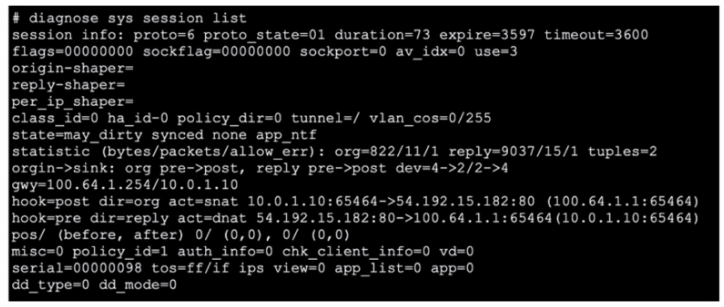Master Fortinet NSE7_NST-7.2 Exam with Reliable Practice Questions
There are four exchanges during IKEv2 negotiation.
Which sequence is correct?
Correct : D
IKE_SA_INIT:
This is the first exchange in IKEv2. It establishes a secure, authenticated channel between peers and negotiates cryptographic algorithms and keys.
IKE_Auth:
The second exchange authenticates the IKE SA (Security Association) using the previously negotiated keys and algorithms. This exchange also establishes the first IPsec SA.
Create_CHILD_SA:
This exchange creates additional IPsec SAs after the initial authentication. It can also be used to rekey existing IPsec SAs to maintain security.
Informational:
This is a generic exchange used for various purposes such as error notification, deletion of SAs, and other control messages.
Fortinet Community: IKEv2 packet exchanges and troubleshooting
Fortinet Documentation: IPsec VPN Concepts
Start a Discussions
Exhibit.

Refer to the exhibit, which shows the output of diagnose sys session list.
If the HA ID for the primary device is 0. what happens if the primary fails and the secondary becomes the primary?
Correct : C
Session Synchronization:
FortiGate HA (High Availability) ensures that active sessions are synchronized between the primary and secondary devices. This synchronization allows for seamless failover and continuity of sessions.
Handling NAT Sessions:
The session in the exhibit has NAT applied, as indicated by the hook=post dir=org act=snat entry. FortiGate's HA setup is designed to handle such sessions, ensuring that traffic continues without interruption during failover.
Session Preservation:
Even with the presence of NAT, the session state is preserved across the HA devices. This means that ongoing sessions do not require re-establishment by the client, thus providing a seamless experience.
Fortinet Documentation: HA session synchronization and failover
Fortinet Community: Understanding session synchronization in FortiGate HA
Start a Discussions
Refer to the exhibit, which shows the omitted output of FortiOS kernel slabs.

Which statement is true?
Correct : B
Kernel Slabs Overview:
The slab allocator in the Linux kernel is used for efficient memory management. It groups objects of the same type into caches, which are divided into slabs.
Each slab contains multiple objects and helps to minimize fragmentation and enhance memory allocation efficiency.
Interpreting the Exhibit:
The exhibit shows output related to various kernel slab caches.
The line for ip6_session indicates that there are 1300 kB allocated for this slab, which means the total memory size allocated for IPv6 session objects in the kernel is 1300 kB.
Linux Kernel Documentation: Slab Allocator details (Hammertux).
Start a Discussions
Refer to the exhibit, which shows the output of diagnose sys session stat. Which statement about the output shown in the exhibit is correct?
Correct : C
Session Table Overview:
The session table in FortiOS tracks all active and pending sessions. It includes details like the type of session (TCP, UDP, etc.), status, and statistics.
Interpreting the Exhibit:
The exhibit from the diagnose sys session stat command shows detailed session statistics.
The specific value indicating '166 TCP sessions waiting to complete the three-way handshake' reflects the number of sessions that have initiated but not yet completed the TCP three-way handshake process (SYN, SYN-ACK, ACK).
Fortinet Documentation: Understanding and troubleshooting session tables (Hammertux).
Start a Discussions
What are two functions of automation stitches? (Choose two.)
Correct : B, C
Automation Stitches Overview:
Automation stitches in FortiOS allow administrators to automate responses to specific events, such as running diagnostic commands or taking corrective actions when certain thresholds are exceeded.
Diagnostic Commands and Alerts:
Automation stitches can be configured to run diagnostic commands and attach the results to email alerts. This is useful for monitoring and troubleshooting purposes, particularly when CPU or memory usage exceeds set thresholds.
Sequential Execution with Parameters:
When actions are executed sequentially, each action can take parameters from the previous action as input. This enables more complex workflows and automation sequences where the output of one action influences the next.
Start a Discussions